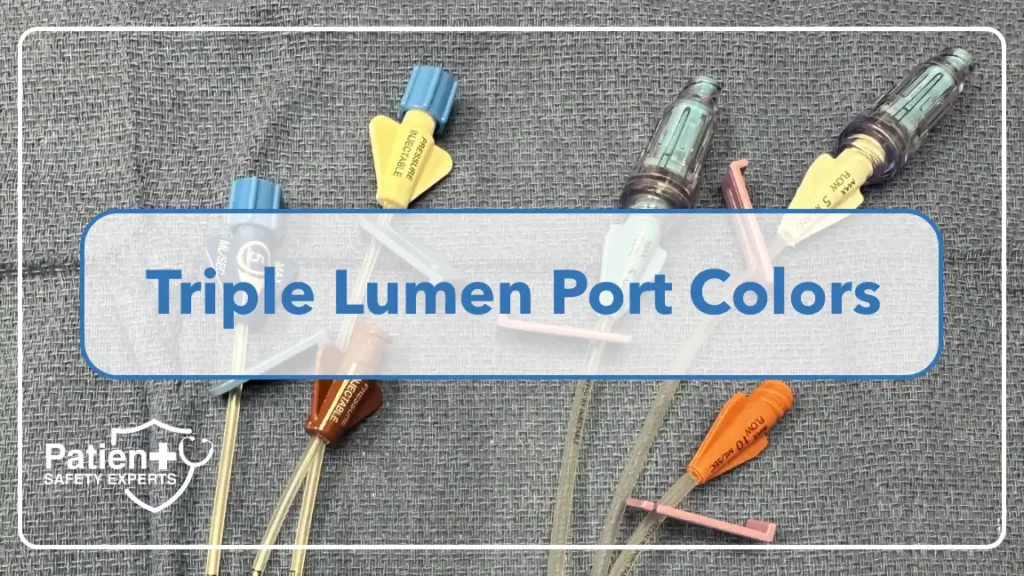Table of Contents
- Introduction to Triple Lumen Central Venous Catheters
- The Significance of Port Colors
- Understanding the Colors: A Detailed Look
- Clinical Implications and Best Practices
- Real-life Examples and Applications
- Conclusion
Introduction to Triple Lumen Central Venous Catheters
Central venous catheters (CVCs) are indispensable in modern medicine. Among the various designs, the triple-lumen CVC stands out for its multifunctionality. With three distinct channels, nurses, physicians and APPs can deliver multiple treatments simultaneously. However, each lumen is designed for a specific purpose, and their colors play a crucial role in patient safety and efficacy of care.
- Why Triple Lumen CVCs? They offer the convenience of multiple treatments without the need for separate catheters.
- Complexity of Care: Each lumen serves a unique function, and its misuse can lead to complications.
The Significance of Port Colors
The color-coding system of the lumens is not just for aesthetic purposes. These colors provide a quick visual guide for healthcare professionals, ensuring that each lumen is used correctly. Misuse can lead to dangerous complications, including drug interactions or incorrect dosages.
Key Benefits of Port Colors:
- Safety: Prevents wrong-route administration of drugs.
- Efficiency: Streamlines the workflow in intensive care units.
- Standardization: Facilitates uniformity in training and clinical practice.
Prominent Manufacturers of Triple Lumen Catheters
Depending on who your hospital uses for their supplies. There are a few prominent manufactures of triple lumen catheters in the USA market.
Here’s a table featuring the main manufacturers:
| Manufacturer | Product Name |
|---|---|
| Medline | Vantex Catheters |
| Teleflex Incorporated | Arrow Catheters |
| Cook Medical | Cook Catheters |
| Becton Dickinson | Power PICC |
While this table gives an overview of the companies in the market, remember to ensure that the information you seek is up-to-date, as the medical device market can be dynamic, with mergers, acquisitions, and evolving product portfolios.
Understanding the Colors: A Detailed Look
The typical colors seen in triple-lumen CVCs are blue, white, and some variation of the color brown. Here’s a breakdown of each color’s significance:
| Color | Location | Diameter | Usage |
|---|---|---|---|
| Blue | Proximal | Larger | Low pressure such as fluid administration |
| White | Middle | Medium | Blood draws and drug administration |
| Brown | Distal | Smallest | High-pressure infusions or central venous pressure monitoring |
- Blue (Proximal) Port: Used primarily for fluid administration due to its larger diameter. This ensures smooth flow without causing damage to the catheter.
- White (Middle) Port: Ideally suited for blood draws. Its medium size allows for easy collection without clogging.
- Brown (Distal) Port: Built for high-pressure activities. Its smaller diameter can handle pressure and is often used for vital procedures like central venous pressure monitoring.
The placement of the CVP monitoring tubing
The attachment of the CVP on the most distal port of a central venous catheter is essential to obtain accurate measurements of central venous pressure. Here’s why:
- Catheter Tip Location: The distal port is closest to the tip of the catheter, which is ideally positioned within the patient’s superior vena cava (SVC) or right atrium. Placing the monitoring tubing in this port ensures that pressure readings are taken at the most representative location within the central circulation.
- Avoiding Confounding Factors: If the tubing is attached to a proximal port, it may inadvertently measure pressure changes occurring in the catheter itself or in a less central location, such as the subclavian vein or internal jugular vein. This can lead to misleading readings, potentially affecting clinical decision-making.
- Accurate Hemodynamic Assessment: Accurate CVP measurements are crucial for assessing a patient’s fluid status, guiding fluid resuscitation, and managing conditions like heart failure. Errors in measurement can result in incorrect clinical decisions, which may impact patient outcomes.
- Preventing Catheter-Related Complications: Proper placement of the monitoring tubing in the distal port minimizes the risk of catheter-associated complications, such as thrombosis or catheter-related bloodstream infections, which can occur if the catheter tip is not in the optimal position.
Attaching the CVP monitoring tubing to the most distal port of a central venous catheter is essential to ensure precise and reliable measurements of central venous pressure, which is critical for patient care and clinical decision-making in healthcare settings.
Clinical Implications and Best Practices
Recognizing the colors and understanding their specific uses can significantly enhance patient care. However, relying solely on colors can be dangerous. Best practices include:
- Regular Training: Ensure all team members are up-to-date with the color-coding system and its implications.
- Labeling: Besides the inbuilt color, always label each lumen with its intended use.
- Regular Inspections: Check the catheters for signs of wear and tear, ensuring the colors are still visible and distinguishable.
- Patient Education: Inform the patient about the purpose of each lumen. This can act as an additional safety measure in case they notice any inconsistencies.
Real-life Examples and Applications
1. Emergency Settings: In a trauma situation, the blue lumen can be used for rapid fluid resuscitation, while the brown lumen can monitor central venous pressure, guiding fluid therapy.
2. ICU Settings: For a patient with multiple medications, the white lumen can be reserved for drug administration, ensuring no mixing with other substances.
3. Dialysis: In patients awaiting a permanent dialysis catheter, the blue lumen’s larger diameter can temporarily facilitate dialysis.
Considerations in Application:
- Always verify the correct port before administering any substance.
- Regularly monitor for potential complications, like infections or blockages.
Conclusion
The triple-lumen central venous catheter, with its color-coded system, epitomizes the blend of design and functionality in medical devices. While these colors provide a roadmap for care, they should not replace the comprehensive knowledge and vigilance required in patient care. Em
bracing the colors, understanding their significance, and following best practices can ensure optimal patient outcomes.












